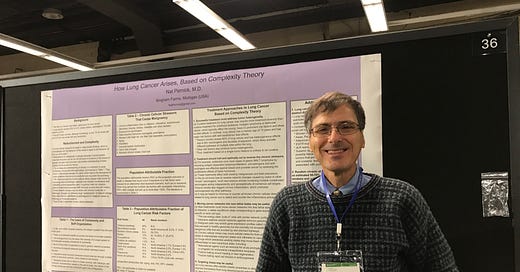The scientific process - advancing cancer knowledge
8 December 2023
This essay discusses Abstract A135: Are survival benefits of new drugs in combinations due to modest benefits in most patients or large benefits in few patients? This abstract was presented at a recent conference held by the American Association of Cancer Research, the National Cancer Institute and the European Organisation for Research and Treatment of Cancer. These conferences provide an opportunity for physicians and scientists to present their research. Typically, hundreds of abstracts are presented in the form of 4’ x 6’ posters. The abstract authors stand by their posters and get feedback from conference attendees. Some research is also presented in 15 minute talks.
The drug survival abstract describes a method that helps clinicians gain a better understanding of how cancer patients benefit from prolonged survival through the use of drug combinations, as well as how long those benefits last.
For studies showing an overall modest improvement in survival, the authors considered the following questions: Was it because (a) most patients had a similar modest improvement, or (b) did some patients have a much better improvement while others had only minimal improvement? In both cases, the average improvement in survival might be similar.
The conclusion was there were often a small number of patients who experienced much greater survival times, which would not be noticed by just looking at the overall average of all the patients. The next task was to determine what factors (personal to the patient or tumor related) are associated with improved survival in the patient population that was studied. Typically, the authors expand on the abstract with more data and analysis within a detailed journal article that occasionally has different conclusions!
Some basics about cancer research:
The goal of cancer treatment is improved survival with substantially fewer cancer deaths.
Cancer types are considered curable if the survival after 5 or 10 years approaches 80% or more of all patients.
The history of cancer research demonstrates that reaching a cure typically involves a trickle of small improvements over decades in different aspects of cancer treatment. When combined, these small improvements are not just additive but can lead to the creation of new treatments that have a much bigger impact.
Index to Nat's blog on cancer and medicine
If you like these free essays, please share them with others.
Follow me on Substack or LinkedIn or through our Curing Cancer Newsletter (all are free). I have another blog on politics and abortion rights
Follow our Curing Cancer Network on LinkedIn and Twitter to view interesting images of cancer diagnoses, cancer essays and other cancer news.
Latest versions of our cancer essays:
American Code Against Cancer (how you can prevent cancer)
Email me at Nat@PathologyOutlines.com - Unfortunately, I cannot provide medical advice.
I also publish Notes at https://substack.com/note. Subscribers will automatically see my notes.
Other social media - Tribel: @nat385440b, Threads: npernickmich




